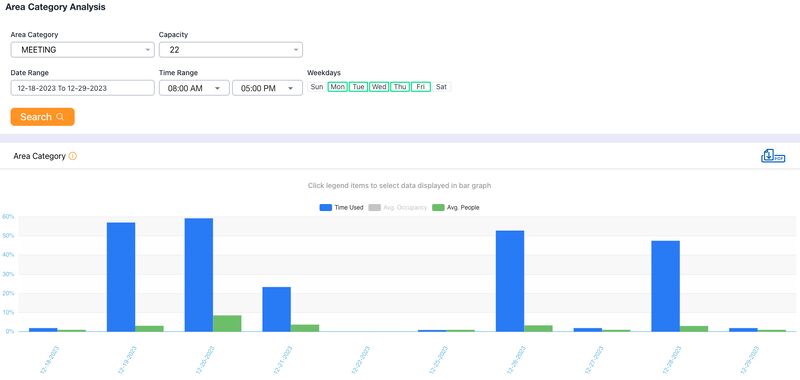Some companies have adopted an incentive-based approach rather than issuing ultimatums in the tug-of-war over working from home and returning to the office. During the COVID-19 pandemic, many workers who were suddenly required to work from home became accustomed to the advantages and have resisted a full-time return to the office.
The US Chamber of Commerce cites research showing that 61% of workers want to continue working remotely, and 40% of those with a hybrid schedule allowing at least one remote day per week claim they would quit if their company eliminated the option.
Luring those employees back to the office, full-time or part-time, is a challenge for many employers. One obstacle to reaching higher in-person attendance might be the space itself. How frustrating is it to come into the office and find the conference room you needed for an important meeting is overbooked? Or space wasted with empty desks when what you really needed was a quiet place to take a phone call?
Aligning the office environment with employee needs can not only affect attendance and productivity rates, but also impact employee retention rates, ultimately saving the company on hiring costs. To achieve this, companies need to better understand both generally what employees are looking for and specifically how their space is currently being utilized by employees.
Envoy (which offers workplace management tools) surveyed employers about their efforts to encourage workers to return to the office. The strategies include:
- 88% are using incentives ranging from free snacks to additional compensation.
- 77% have an individually crafted hybrid policy to meet the company’s needs.
- 61% are making physical changes to the workplace.
- 5% have no attendance policy.
According to a recent report in the Wall Street Journal, office vacancies in the US have reached nearly 20%. That is the highest vacancy level since 1979. Of course, the problem isn’t just the shift from a traditional 5-days-a-week-in-the-office mindset to a remote or hybrid approach. Other influences help keep occupancy rates down. Overbuilding in the 80s and 90s created long-term excess capacity. Also, many companies have slowly or quickly changed their approach from single office layouts to more communal designs, including cubicles and open floors. These buildout strategies require fewer square feet per person.
How do you know if your company is laid out ideally for efficiency and to encourage workers to show up in person?
Addressing this question before or in conjunction with issuing a policy regarding remote vs in-person work rules is vital. Researching your space’s current and optimal use can support your employees as they return to the office.
Suppose you have a layout incorporating offices, cubicles, and communal spaces like meeting rooms, break rooms, and collaborative workspaces. This design is pretty typical and may meet your needs. The original layout probably included one workspace per person, and that may not be the best use of space today. The conference rooms may be smaller or larger than needed, and you may have an excess number or a shortage.
One effective way to determine whether you currently have an optimal space design is to measure the usage. Measuring usage goes far beyond counting badge swipes to determine how many people show up daily. Usage measurements can tell you what spaces employees use and do not use.
Just because your space is used, does not mean it is being used well. Take this real-life example. A group of large conference rooms (capacity of 22) are being used >50% of the time on peak days. You know from the reservation system that these rooms are well-used. But wait! What the reservation system won’t tell you is that when these spaces are occupied, they are only being used by an average of 2.2 people. So, yes, the 22-person conference rooms are used often, but not for the purpose they were designed. Access to this information may lead your company to consider changing the layout to include a larger number of smaller conference rooms. AVUITY makes it easy to identify these scenarios and highlight opportunities to improve space efficiency and design.

Next, consider the information you need to determine an ideal workspace-to-employee ratio. The traditional formula of one workspace per employee may no longer be appropriate for your operation. You may not need as many designated seats if your workforce employs a hybrid location model. Suppose that employees work in the office three days per week and two from home. It makes sense to consider a layout where some seats are shared, using a hot seat or hoteling protocol.
You can use the space you free up by reducing dedicated workstations to create additional collaborative spaces, including conference rooms, break rooms, huddle spaces, and amenities.
How can I obtain accurate data that can guide my approach to space planning?
Accurate and robust data on occupancy, headcount, and environmental metrics is simple to collect using AVUITY’s sensor technology. AVUITY has options for point-in-time data or ongoing data collection that can help you better understand how employees are using the space. In addition, this technology can save money on environmental factors by adjusting heating and air conditioning in unused spaces.
Good decisions start with actionable, accurate information. Space utilization data helps you plan for growth, manage facility costs, and enhance workplace satisfaction. AVUITY’s space utilization platform collects utilization data that offers insightful information.
What information will AVUITY sensors provide?
Advanced devices like AVUITY sensors will not only tell you how many people are in the office, but they will also provide far more detailed usage information:
- When and for how long each space is occupied.
- How many people are in each space.
- What level of lighting is used and what is the temperature and humidity reading.
AVUITY’s technology can collect the data over specified periods and help you plan changes based on usage. Consider some of the potential changes that might benefit your organization. First, you might decide you need less space than you currently occupy. Rightsizing saves money and contributes to the overall enjoyment of the office. Undoubtedly, it’s unsettling for workers to walk past rows of unused cubicles to take their seats in a barely inhabited section of the facility. Camaraderie and employee morale get a boost from bustling, well-used spaces.
Also, if you decide to retain your current square footage, you may gain an advantage by changing the layout. Sensors can help with this, and you may also want to survey workers to understand their preferences. Employees may be motivated to return to the office more frequently if some current space gets converted to meeting spaces or repurposed with certain amenities.
A positive and productive office space will not only help companies in their effort to draw current workers back to the office but also support recruiting efforts. While collaboration is a key focus, companies are also including changes that enhance the productive use of technology. These changes may include designing workstations and conference rooms with wireless charging stations, adjustable lighting, and flexible layouts.
The bottom line is that companies are more likely to succeed when they create and support a workplace that attracts employees and fosters their productivity. To design and implement effective changes, you must first gain access to the robust data that will guide your way. AVUITY sensor products are a clear advance in utilization technology that can help create your ideal path forward.


